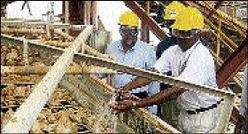John Myers Jr, Senior Reporter

State minister in the Ministry of Mining and Telecommunications, Laurie Broderick (left), watches as Rugby Jamaica Minerals managing director, Norman Davis, demonstrates the processing of cleaning mined aggregates at the plant in Halse Hall, Clarendon. - contributed
With estimated reserves of at least 60 billion tonnes, Jamaica, the experts say, is merely scratching the surface of the potential value from mining limestone. The island is yet to exploit the true potential of the mineral and its associated downstream industries.
But the Government is intent on changing all that, planning over the decade to develop an industry worth tens of billions of dollars, employing thousands of people and contributing up to US$320 million a year to the national coffers by way of taxes, royalties and other expenditure.
"We are speaking about a potentially huge industry," said Oral Rainford, senior director of policy in the mining and telecommunications ministry. "The problem is that it is in its infancy. But we are going to see over the next five to 10 years that it moves quickly."
A policy document, setting a broad framework for the development of the mineral sector, outside of the well-established bauxite-alumina, was recently released.
But it is in limestone, apparently, that officials see the more immediate potential, not least for the fact of the huge reserves. Jamaica is, primarily, a limestone formation, experts say.
And there is already something of a limestone industry here, small though it is. Just over half a million tonnes of the raw mineral is exported annually.
Lime importation
Another small amount is turned into lime, at two plants here, to be used in the calcination process, when bauxite is being refined to alumina.
Yet, Jamaica imports up to 90,000 tonnes of lime a year to meet the demands of the alumina industry, and could require an additional 100,000 if planned expansion of alumina refineries go-ahead.
Importing industrial lime to Jamaica "should not be happening," the technical expert Rainford complained, during a Financial Gleaner interview.
Laurie Broderick, the junior mining minister, agrees.
"The time has come for us to hasten the diversification of the entire minerals industry with emphasis on the production of value-added products," Broderick told legislators in August, during a report on his portfolio responsibilities.
By Broderick's estimate, if the mineral sector really gets going, its combined gross value would be $184 billion a year.
The minerals under consideration include:
Gypsum
Sand and gravel
Hard volcanic rocks (from which skid aggregates are produced)
Clay
Semi-precious minerals, including marble and granite
Shale; and Pozollan, used by the local manufacturer of Portland cement.
Already, the government is finding traction for its policy.
Three years ago, Cemex, the Mexican cement and building material producer, acquired the Clarendon-based Rugby Minerals and Lime, a facility capable of producing 120,000 tonnes of lime a year. Months ago, Cemex announced that it would spend about US$300 million to build a new limestone mining plant in Salt River, Clarendon.
Other foreign firms have also shown interest in either establishing greenfield operations or expanding existing facilities, the Financial Gleaner was told.
It is understood that several foreign companies have expressed interest in setting up operations or to buy out existing operations here.
"There is one out in Lydford, St. Ann (the Lydford mining Company) that already has US$8 million invested and is waiting to invest a further US$90 million in (mining) high quality limestone," Rainford said. "They also want to get into construction grade limestone and material for desulfarisation - that is scrubbing sulfur from coal-fired power plants."
Local demand could soar even higher if government proceed with plans to utilise coal and petcoke for producing energy. The Jamaica Public Service Company, which is to build a US$300 million 120 megawatt petcoke cogeneration plant by 2012, said it would require significant supplies of lime for use in the process of generating electricity.
Additionally, Broderick said there were possibilities for exporting the product to the wider Caribbean and southern US.
"There is also a need for hydrated lime, which is used in purifying steel, sugar and paper," he said.
Add to this the fact that limestone is used in products such as grout, thin-set, paint, soap, toothpaste, tablets, vitamin and mineral supplements and in processing sugar.
"We are convinced of the merits and viability of Jamaica creating an integrated limestone industry," said Broderick.
john.myers@gleanerjm.com

